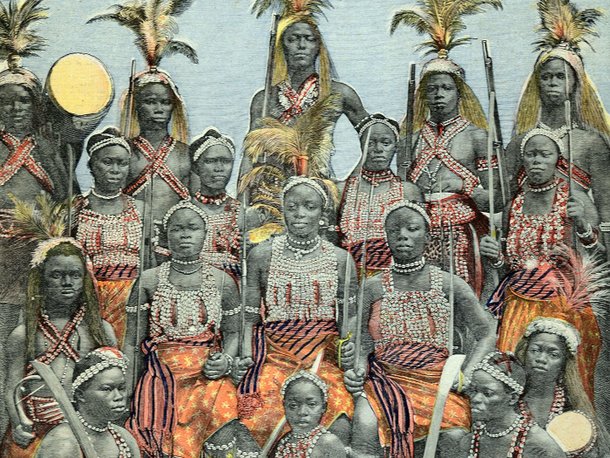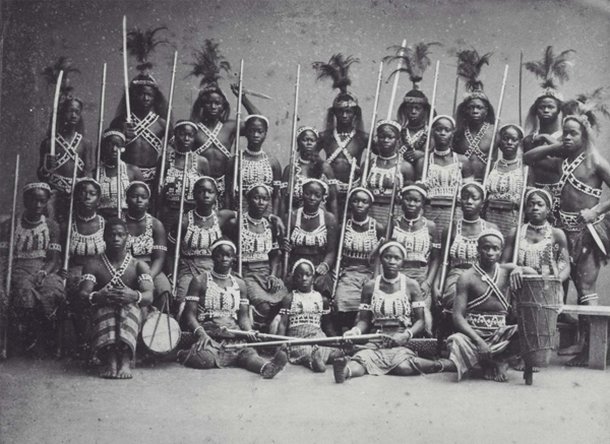O novo filme A Mulher Rei (The Woman King, 2022), estrelado por Viola Davis, mostra uma líder guerreira do exército feminino de Agojie (também chamado Ahosi, Mino ou Minon), que fazia parte do reino de Daomé, na África Ocidental. Ainda que a personagem interpretada por Viola seja ficcional, o exército realmente existiu e era composto por 6 mil guerreiras.
As chamadas “Amazonas de Daomé” estabeleceram o poderio de seu reino contra regiões vizinhas. E o filme, dirigido por Gina Prince-Bythewood, procura fazer jus à história dessas mulheres guerreiras que dominaram parte da África na década de 1840.
A história real atrás de A Mulher Rei

O filme começa em 1823, após um ataque bem sucedido das Agojie, libertando escravos que estavam nas mãos do Império Oyo em uma região localizada no sudoeste da Nigéria. Embora o povo de Daomé seja submisso a Oyo, nesta época estava havendo um princípio de rebelião coordenada pelo rei Ghezo (John Boyega) e a general Nanisca (Viola Davis). Ambos desprezam o comércio de pessoas escravizadas.
Ghezo, de fato, existiu e libertou Daomé em 1833. Contudo, há algumas imprecisões no que é retratado pelo filme, uma vez que o reino de Daomé teve um papel central do tráfico de escravos, vendendo seus cativos para comerciantes europeus.
Na verdade, o rei Guezo só concordou em retirar Daomé do tráfico de escravos em 1852, por conta da pressão feita pelo governo britânico em cima de suas colônias. A partir de então, o reino ou a focar na produção de óleo de palma, que era bem menos lucrativo. Por isso, o rei retomou logo em seguida o comércio de escravizados.
Quem eram as Agojie?

As guerreiras Agojie eram, inicialmente, as esposas do rei. Entretanto, com o tempo, mulheres comuns da sociedade foram se voluntariando para participar deste exército. Era um grupo de mulheres caçadoras de elefantes que logo se tornou parte da guarda do exército.
Por causa das guerras em curso, Daomé perdeu muitos homens e as mulheres começaram a substituí-los cada vez mais no campo de batalha. Outra característica interessante para a época é que este exército usava uniforme, o que significava que ele queria ser reconhecido publicamente e temido pelos povos vizinhos.
Os historiadores dizem que as Agojie, por mais que tenham sido símbolo de força e poder, também eram cúmplices de um sistema problemático. Afinal, elas estavam dentro de um sistema patriarcal e ligadas ao comércio de pessoas escravizadas.
Além disso, ser esposas do rei não significava ter muitas regalias. Na verdade, as Agojie eram como “esposas de terceira classe”: elas normalmente não compartilhavam sua cama ou tinham filhos com ele. Mas, por serem casadas com o rei, eram proibidas de fazer sexo com outros homens, o que quer dizer que se esperava que fossem celibatárias.
Dentre os “privilégios”, estava o o que as guerreiras tinham a um suprimento constante de tabaco e álcool, e também de terem seus escravos particulares.
O treinamento das Agojie

Não era fácil se tornar uma Agojie. Elas avam por um treinamento intenso, o que incluía exercícios que as preparavam para batalhas sangrentas. Isso envolvia, por exemplo, ataques simulados a outros povos em que tinham que escalar descalças muros cheios de espinhos. Estas guerreiras avam por toda essa dor sem reclamar.
O exército das Agojie se dividia em cinco ramos: as que lutavam na artilharia, as caçadoras de elefantes, as arqueiras, as mosqueteiras (que empunhavam mosquetes), e as que lutavam com navalhas. Uma parte importante de seu treinamento consistia em conseguir surpreender o inimigo, pegando-o desavisado.
As Agojie entraram em batalha contra o exército francês na segunda metade do século XIX, o que levou ao fim deste grupo e ao apagamento das suas memórias. A professora Lynne Ellsworth Larsen, que estuda as dinâmicas de gênero entre os Daomé, aponta que estas mulheres guerreiras perturbavam a compreensão dos papéis de gênero: “A ostentação de ferocidade, poder físico e destemor destas mulheres foi manipulada ou corrompida à medida que os europeus começaram a interpretar isso de acordo com o seu contexto”, contou.
Fonte: MegaCurioso.